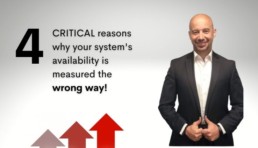4 CRITICAL reasons why your system's availability is measured the wrong way!

4 CRITICAL reasons why your system's availability is measured the wrong way!
4 CRITICAL reasons why your system's availability is measured the wrong way!
In one of my recent assignments, I was surprised to hear the CEO of a large financial institute, critically criticizing his employees on how they are calculating their system’s availability! He was totally upset about the way they’re conducting such a calculation! They were simply checking the physical availability and uptime of their systems, ignoring the percentage of users that are using the system, and even ignoring the complaints of their clients on social media! this argument enticed me to write up this article. I think we will all benefit from such an experience.
Intro and history of online services:
The infamous way to report the availability of systems across ALL-Channels is by checking the availability of the hardware uptime/load balancer/s, backup solutions, and the availability of the software itself. In other words, the old way, or shall I call it the obsolete way of checking the availability of a system is if it’s up and responding or not!
Most professionals and technical peers, think of systems availability as if it’s only the uptime of the systems, and high availability from a software and hardware perspective only! But in reality, the BFSI (Banking, Financial Services, and Insurance) are all in the business to capitalize on their assets. Such businesses survive by providing top-of-the-line financial services/solutions to their clients, and capitalize by on-boarding high-value customers, cross-selling, or up-selling new services to their current clients. Thus, bankers got intensive homework to do prior to promoting a service to a client! , first, they need to check if such the service will fit the needs of certain clients since each and every client has different needs. Moreover, it’s very important to point out that the onboarding of high-value clients is a costly process, so they don’t want their customers to churn!
The new era of doing business:
Based on the previously mentioned points, and the extensive competition between Financial institutes, FinTech’s, Neo-Banks & Challenger banks, and telecoms, such BFSI institutes need to change the way they check the availability of their systems. In other words, are their systems addressing their customer’s needs, behaviors, or is their corporate message reaching their customers across ALL-Channels appropriately?
4 Reasons your system’s availability is totally wrong! and here is why!
It’s time to re-think how we are calculating the uptime and availability of our systems! it’s time to address your customer’s needs. At the end of the day if you are not addressing your customer’s needs, then you are wasting your resources and efforts. If you want to calculate your uptime or availability from an IT perspective, then your business will not thrive, and no one will use your systems!
1- User behavior:
It’s extremely important to keep your systems evolving to meet your customer’s behavioral needs. So, try to expand your system’s health check report to include such data/information. This information will be extremely beneficial for the enhancement of your systems, plus you might drop certain services and replace them with other more important ones, and all of this depends on your customer’s behavior. Or you might optimize your systems to address the behavior of certain clients. By following such steps, you’ll end up increasing the overall usability of your systems.
2- User Experience:
User experience is a critical aspect to the success of your overall systems usage. Thus, it’s vital to keep checking for abandoned services or transactions. Plus, it’s important to investigate the reasons behind such abandonments. By doing such an investigation, you’ll be able to uncover any obstacles that your clients are probably facing on a daily basis. Maybe your customers are dealing with complex interactions, which preventing them from conducting their transactions. Or maybe the system performance is not up to your customer’s expectations, or it could reveal other complex functionalities.
For example, You can check how often your customers are using their mobile application to do an ACH fund transfer?
Or another example: Are your customers leaving you because you don’t have services, which your competitors are providing?
3- Social media feeds!
Today, social media is the largest global market. This market has no boundaries, and those who played in this domain had gained immensely. Many of the corporates forget the criticality of checking the complaints (or suggestions) of their clients on social media. It’s not all about negative comments! I think it’s important to check the positive comments as well to keep doing what’s best for your customers.
But taking into account the negative comments, and work diligently to address them, is very critical for the thriving and growth of the business. Addressing such comments shall be on multiple dimensions, from the social feeds responses all the way to the systems level. Subsequently, if you don’t address your customer’s needs, then their satisfaction will drop, and they’ll end up taking their business somewhere else.
So, in other words, check our customer’s feedback and overall satisfaction, and this part will assist you in enhancing and revamping the user experience/journey and thus address the user needs.
4- Your Marketing message!
The only way to evaluate your success is to check your marketing message penetration. Thus, you can check such penetration by checking your audience behaviour and usability to your e-channels. In plain english; are your customers getting the proper marketing message from your firm?
Plus, are you able to provide them with a specific tailored offer that will address their daily needs, and enhance their overall user experience?
To accomplish the above, you can set a list of listeners, some of them will be listening and providing you with the overall customer’s wants and needs, plus your audience’s overall sentiment. A list of KPIs will be enormously beneficial to measure your overall success.
So, which tools shall you use? In most of my posts, I’m technology agnostic, since what may work for someone might not work for others!. But, hit me with a line if you need any advice.
5 Critical Reasons Digital Transformation is Vital to the Survival of your Business! # 1 Will save your Business

5 Critical Reasons Digital Transformation is Vital to the Survival of your Business! # 1 Will save your Business
What’s Digital Transformation;
Digital transformation can be defined as “the acceleration of business activities, processes, competencies, and models to fully leverage the changes and opportunities of digital technologies and their impact in a strategic and prioritized way.”
Reference: <https://www.cio.com/article/3063620/it-strategy/digital-transformation-why-its-important-to-your-organization.html>
Why digital transformation is vital to the survival of financial firms?
1. The current market is very competitive, and therefore:
Fintech corporations are disrupting the financial market with their new innovative financial instruments. Such corporations were able to introduce new “innovative” revenue streams. Such companies were able to digitize most of their vital monetary services, and thus that is able to reach the masses.
2. In order for financial corporations to survive this new market disruption;
such financial firms have to enhance their digital capabilities and keep up with the world trend.
3. Digital transformation will lower the firm’s OPEX, but they might endure a short-term high CAPEX.
Such expenses are mostly due to the purchases or acquiring of new technologies.
4. Digital transformation will enhance the firm’s OMNI-Channel user experience and:
give it the ability to transform its OMNI-Channels to OPTI-Channels (Optimize its channels, thus enhance the overall user experience/journey).
5. And lastly, financial firms need to digitize their operations:
to keep up with their customer’s demands, market changes, and corporate processes and governance.
Forrester’s study (commission by Accenture) explained that digital transformation will increase the financial firm’s profitability, time-to-market, and enhance customer satisfaction.
(Reference: https://www.accenture.com/us-en/interactive-index)
McKinsey report states that there is a huge Customer demand to conduct most of their financial transactions and do their chores from the comfort of their homes. Thus, its compulsory for businesses to digitize their services to adhere to customer needs, and those who fail to comply will be irrelevant and slashed with losses in the near future.
(Reference: Andersson, H. and Tuddenham, P., 2014. Reinventing IT to support digitization. McKinsey, New York.)
References:
8 Outrageous Reasons why your Bank's Process Automation FAILS! , #8 Will Insure Your Success!

8 Outrageous Reasons why your Bank's Process Automation FAILS! , #8 Will Insure Your Success!
One of the main pillars of digital transformation is automation, and to be precise it’s Robotic Process Automation (RPA). When it comes to such an initiative, many companies fail to execute such projects, and this is due to many issues which I’ll go over them in detail in this article. I believe that such projects will enhance the company’s overall capabilities, and thus enhance the maturity of the corporate, and control and lower its overall expenses.
So, here are the main reasons that cause such initiatives to fail:
1- No Clear processes: Automation, in general, depends directly on the corporate internal processes and their maturity. But, if your corporate processes are ill-defined or they are not set clearly to the employees and vendors (3rd party engagements), then the possibilities of building and executing such an automated process will be unachievable.
My advice is to have a clear vision of the type of processes that need to be automated and then, start automating such processes. I believe we don’t need to have ALL of the processes set and defined right from the beginning, but you’ll need some processes ready to be automated. Otherwise, you’ll end up waiting for a long period of time until all processes are defined and used.
2- No Technical Clarity: I believe having a technical ability is a key enabler to such projects, otherwise you’ll end up at the mercy of your vendors. In such cases, having the ability to understand and evaluate the capabilities of the needed tools and mapping them to your needs is crucial for the success of such projects. It’s important to understand that there is NO ONE SIZE fits all type of deal when it comes to process automation.
3- Lack of commitment: When it comes to such projects, full dedication needs to be given to such an initiative. Otherwise, such projects will end up failing. Such projects will require; technical expertise, such expertise needs to cover both the business processes and the technical technology aspect of the project. Moreover, a proper budget, scope, and timeframe need to be decided right at the beginning of such projects.
RESISTANCE is one of the main reasons why some corporations lack the proper commitment, and the reason behind this resistance is the fear of job security after the completion of such projects.
4- Changing processes: It’s important when starting such a project to lock up your processes, otherwise this project will fail due to scope creep. In other words, you don’t want the process/scope of this project to continually change. You can enhance such processes in the future and cooperate with such changes in your future project enhancement, or create a CR change request to accommodate such changes.
5- Complex cognitive tasks: Some tasks could be extremely complex and require a lot of manual human intervention. For such tasks, you’ll need to make sure to jot down all of the required steps, in order to ensure full coverage of the process. Then you can start the automation of such a process, finally, you should run it in attended mode. By running it in attended mode, you’ll get the RPA ML “Machine Learning” to learn all of the possible logical steps for this process.
6- Poor strategies or Tools: When it comes to RPAs, it’s important to have a clear overall strategy of what you want to accomplish. Meaning, you’ll need to understand your corporate Value Chain fully, and then build a strategy to address your customer needs first, then your internal process. Once you understand your corporate Value Chain fully, then you can start drawing your vertical and horizontal processes and their intersects. Plus, you can evaluate each vertical (and horizontal line of business) from the front-end systems – to the middle systems – all the way to the back-end systems.

( Referrence: https://www.mckinsey.com/industries/financial-services/our-insights/the-transformative-power-of-automation-in-banking# )
As for the tools, there are a lot of tools to choose from, but I rather select a tool that fits my requirements and needs. Plus, such a tool needs to be able to integrate and interact with your systems with ease. I’ll be discussing this item in further details in the future.
7- Lack of communication: Enterprise automation processes require the involvement of all of the departments, and it will require all of the involved SMEs to support such an initiative. In large organizations, it’s very difficult to quantify the list of processes. Thus, it’s critical to have a clear and open communication channel between all team members. Such members will need to quantify the processes that need to be automated, their prioritization shall be based on their qualitative and quantitative analysis.
8- Lack of KPIs: Key Performance Indicators are critical to evaluating the overall success of such projects, this way you’ll need to measure and quantify the number of automated processes and the overall throughput of such processes during a certain time period. Subsequently, it’s critical to measure your overall financial impact of such initiative, and it’s short-term and long-term impact on the corporate human resources. When it comes to KPIs, its important to be able to assess the previous KPI measurements, current and based on the KPI outcome try to predict the future KPI outcome.
It’s important to note; the re-alignment of the current corporate resources is a very critical aspect to be discussed and inspected throughout such initiatives. Some resources need to be trained and transferred to different units in order for them to survive such a change.



